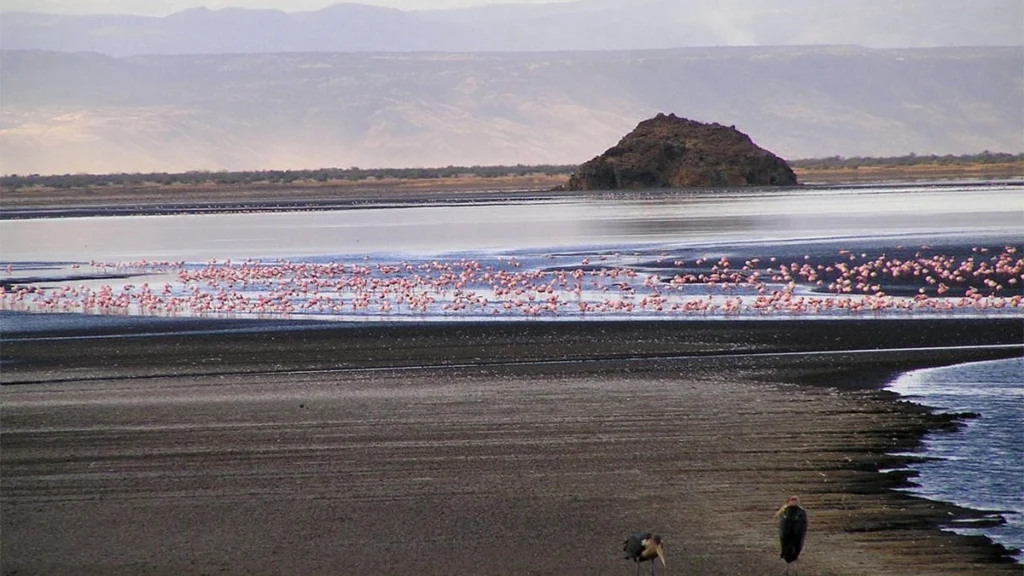Lake Natron
Lake Natron is a saline or alkaline lake situated in northern Tanzania, East Africa. It is situated in a major city within the Arusha area of the country. The Arusha region is a border area that delineates Tanzania from its neighboring country, Kenya. It is purported to be located in the East African Rift Valley. It is situated in the northern section of the Ngorongoro district within the Arusha region of Tanzania.
The lake is situated in the eastern segment of the East African Rift, generally referred to as the Gregory Rift. The basin of Lake Natron contains a Ramsar wetland of worldwide significance. The surface elevation is 600 meters, equivalent to 2,000 feet.
It is a mineral-rich substance commonly referred to as soda in northern Tanzania. It is situated beneath the Oldoinyo Lengai, a prominent active volcano in the rift valley. Individuals, including visitors, are prohibited from consuming water from Lake Natron due of its potential toxicity. Water may induce internal damage akin to that caused by fire; if an individual consumes a sufficient quantity of lake water, the alkaline properties of the liquid could result in burns and perforate the stomach. The stomach ache may become debilitating.

The water is toxic, since consumption can result in gastric irritation. The presence of cyanobacteria in water may induce nausea and potentially result in diarrhea for an individual.
Lake Natron is fed by the Ewaso Ng’iro River, situated in the southern region of the lake. Additionally, it is receiving water from several springs situated adjacent to the lake. These springs are purported to be abundant in mineral resources, enhancing their worth. Lake Natron obtains its water from various sources.
The depth of Lake Natron fluctuates both temporally and spatially. Its depth is reported to be less than 3 meters, about equivalent to ten feet. The width also fluctuates as it is contingent upon the volume of water present in the lake.
The variation in water levels is significantly influenced by frequent and severe alterations in the evaporation process. These processes result in the accumulation of substantial quantities of salt and other mineral resources in the water. This location is characterized by arid terrain that experiences variable precipitation levels. The rainfall in this area is not static; it is dynamic and continually fluctuates throughout time.
Lake Natron is an optimal habitat for flamingos, providing a secure environment for the survival of this particular species, especially the smaller kind. This is due to the environment’s inability to sustain other predatory creatures, making it challenging to access their nests.
Small species of flamingos inhabit saline environments such as Lake Natron, whilst larger species thrive in more hospitable and beneficial habitats. Information Regarding Lake Natron.
Some fish species, such as tilapia, are preferentially found in freshwater and rivers. This is due to their supporting nature in saline and alkaline environments.
Some commercial activity are occurring near Lake Natron, however the area has not yet been evaluated. Certain activities resemble seasonal agriculture and pastoralism.
Significant national initiatives are underway, including hydroelectric power projects anticipated to provide hydroelectricity. These are several projects slated for implementation at Lake Ewaso Ng’iro, located on the border with Kenya.
Tanzania has noted this lake, the sole one in Tanzania and East Africa, for its unique biodiversity, including tiny flamingos inhabiting its coastal regions, in the Ramsar list. The list is designated for highlighting wetlands of global significance. This occurred on July 4, 2001, during the presidency of Benjamin Mkapa in the United Republic of Tanzania.
Lake Natron is subject to many international regulations designed to preserve its longstanding natural and artificial significance. It is also a component of the World Wildlife Fund’s East African halophytic ecosystems.
Several remarkable locations near the lake draw a diverse array of visitors. Some resemble coastal regions adjacent to Lake Natron. There are several sites around the lakeside utilized for climbing the Oldoinyo Lengai volcano. Visitors from diverse locations rejuvenate and take pleasure in their experiences when they ascend the volcano, as well as in the facts surrounding Lake Natron.
Lake Natron is among the premier lakes for swimming. Swimming in Lake Natron may not result in injury, but one could be transformed into stone within the water. Visitors are urged to explore Lake Natron, and for those seeking a more subdued experience, they may enjoy wading and swimming in the largest entirely submerged cave within the lake.
The waters of Tanzania’s Lake Natron are both stunning and perilous, making them alluring for swimming and recreation; however, caution is urged to avoid ingestion of the water.
Moreover, there exist several dangers to the conservation of the lake. The region surrounding the saline lake is largely uninhabited, with minor pastoral activity occurring along the coastline. Cultivation activities pose dangers to the lake by potentially disrupting the salinity equilibrium.

